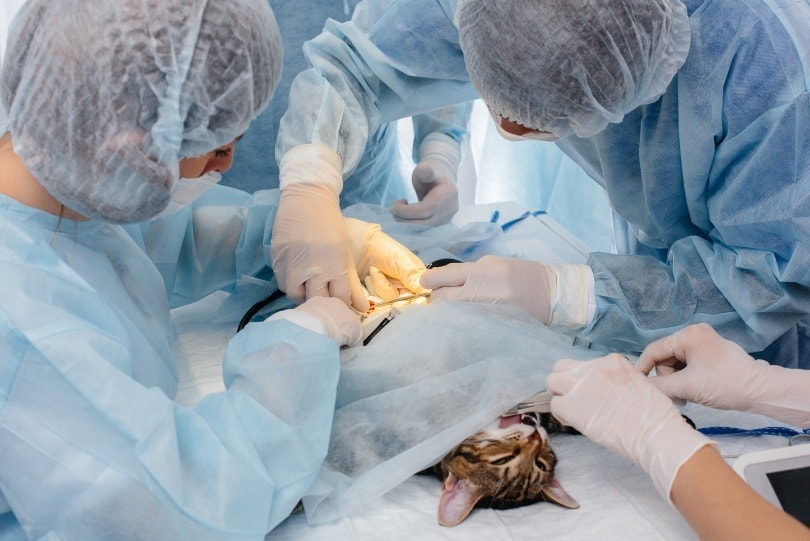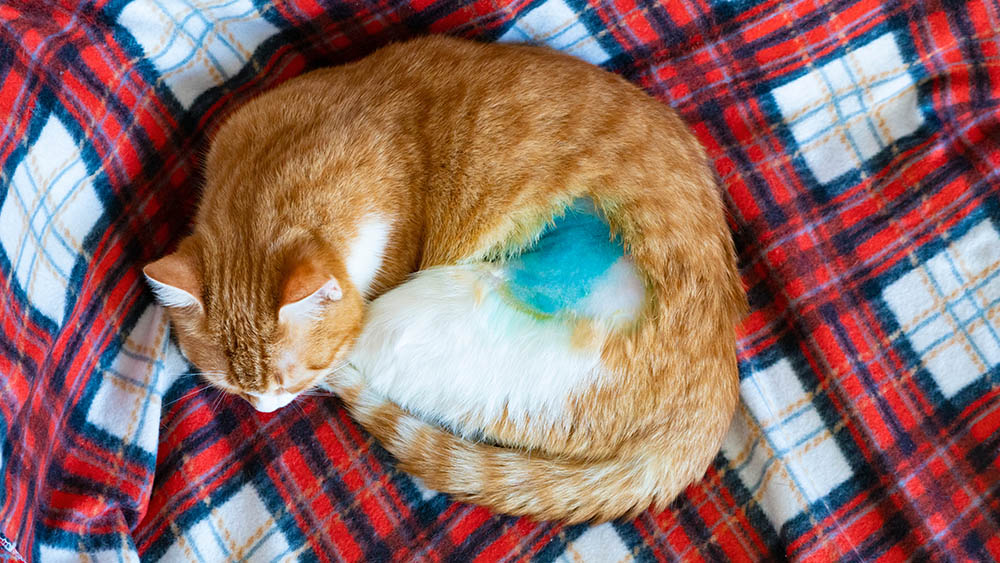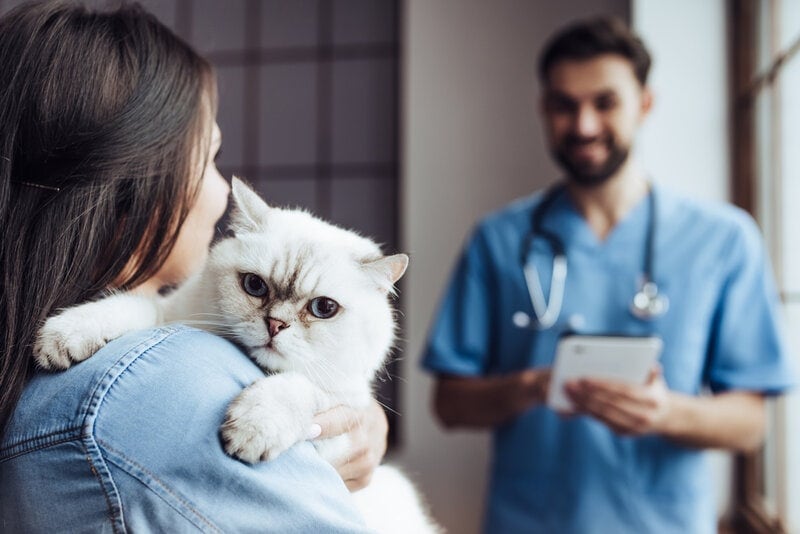How To Tell If A Cat Is Spayed (Vet Answer)

Updated on

As a responsible pet owner, you know the importance of getting your cat spayed. “Spaying” is the common term for an ovariohysterectomy.1 During this surgical procedure, the ovaries and uterus are removed in order to stop a female cat from reproducing. Not only does spaying prevent unplanned litters, but it also helps reduce a cat’s risk of developing ovarian, uterine, and breast cancers. Furthermore, spaying prevents a cat from displaying unsociable behaviors linked to her heat cycle.
If you are planning on adopting, or have already welcomed a female cat with an unknown history into your home, it can be difficult to tell if she has been spayed. There are, however, certain signs that you can look out for that may suggest that she has been spayed. Let’s discuss these signs and other ways to determine if your cat is spayed.
What to Look For in a Spayed Cat
1. A Clipped Patch of Fur
If your cat has recently been spayed, you will see a clipped patch of fur on her abdomen or on the side of her body between the ribs and the hip area, depending on the surgical technique used. There are two techniques for spaying cats: the midline approach, where an incision is made in the midline of the abdomen, just below the belly button, and the flank approach, where an incision is made in the area between the ribs and the hip. The flank approach is performed on either the right or left side of the body depending on the surgeon’s preference.
Prior to the spay, the fur is clipped so that the skin can be disinfected to prevent infection.
It’s important to note that the presence of clipped fur alone doesn’t guarantee that your cat has been spayed as there are other procedures that also require the fur to be shaved.

2. A scar
Spaying sometimes leaves a scar at the incision site. Part or clip the hair along the midline of your cat’s belly and along both sides of the body between the ribs and the hips to check for a thin line of fibrous tissue. The downside to this method is that the scar from spaying is often very thin and light in color and can therefore be difficult to spot, especially if the cat was spayed as a kitten.
The presence of a scar alone doesn’t guarantee that your cat has been spayed as there are other procedures that can cause scarring in the same area.
3. A tattoo
After being spayed, while the cat is still under anesthetic, some veterinarians tattoo a thin line, the letter “S”, or some other mark next to the spay wound or on the inside of the ear, to indicate that the cat is sterilized. These tattoos are permanent and provide an easy way to confirm that a cat is spayed. If your cat happens to have a tattoo, you can say for certain that she is spayed.
This practice has not been universally adopted by veterinarians, so it is possible that a spayed cat will not have a tattoo.
4. An ear notch or missing ear tip
It is common practice to make an ear notch or to remove the tip of a feral cat’s ear under general anesthetic straight after it is sterilized. The left ear is usually tipped or notched. Many feral cats are sterilized and marked in this way through a Trap-Neuter-Return program. This is a three-step process where the feral cat is trapped, then sterilized and ear-tipped or notched, and finally released back into its colony. Trap-Neuter-Release programs help control the population of feral cat colonies and help to eliminate unpleasant mating behaviors that disturb people living in the same area.
Feral cats are for the most part skittish and difficult to handle, so tipping and notching provide an easy way to identify a cat as sterilized, even from a distance.
If your cat has an ear notch or the tip of her ear is missing, it’s possible that she was once trapped and spayed as part of a feral Trap-Neuter-Release program. There are, however, other reasons for a cat to have a missing ear tip such as surgery to amputate the tip of the ear if it is diseased, or it may be the result of cat fights.
Look Out For Signs That Your Cat Is In Heat
An unspayed cat will go into heat when she reaches sexual maturity at around 6 months of age, although it is possible for a cat as young as 4 or 5 months to come in heat. A cat in heat is sexually receptive and capable of falling pregnant if allowed to mate with an unneutered male cat. On average, each heat lasts around six days, with the cycle generally repeating itself every three weeks in spring, summer, and autumn, but typically not in winter.
The most obvious sign that a cat is in heat is a behavioral change. Cats develop unusual behaviors due to the changes in their hormones while in heat. Most cats become unusually affectionate and constantly demand attention, rubbing up against people and objects. A cat in heat may appear unsettled and restless, she may lose her appetite and try to escape. She will vocalize loudly and assume the mating position with her head down, forelegs bent, rear end raised, and her tail raised to the side, exposing the perineum. A cat in heat may even spray urine against vertical surfaces in the home.
This behavior will disappear after about a week when your cat is no longer in heat and is a tell-tale sign that your cat is not spayed.
Get Your Cat Checked By a Veterinarian
If you are still unsure if your cat is spayed, get her checked by a veterinarian. Your veterinarian will start with a physical exam, looking for the signs of a prior spay as discussed above.
If, after a physical exam, your veterinarian is unable to say for certain that your cat is spayed, he or she will advise running blood tests.

AMH Test
The Anti-Müllerian Hormone (AMH) Test is currently the simplest test available to determine if a cat is spayed or intact. The ovaries secrete Anti-Müllerian Hormone. A negative AMH Test is consistent with a spayed female cat, while a positive test indicates the presence of ovarian tissue and that she has not been spayed.
The benefit of the AMH Test, compared to other blood tests currently available, is that it can be run at any time, even when the cat is not in heat, and it does not require the cat to receive hormone treatments in order to perform the test.
If the AMH test is not available in the country in which you live, your veterinarian will recommend a different blood test.
Exploratory Surgery
In some situations where it’s not possible to use a blood test to check if a cat is spayed, a veterinarian may advise performing an explorative laparotomy. During the procedure, an abdominal incision is made while the cat is under general anesthetic to allow the vet to check for the presence of ovaries and a uterus. If the ovaries and uterus are discovered during the procedure, the veterinarian will go ahead and spay the cat. The downside to an explorative laparotomy is that it is sometimes unnecessary. It is also invasive, painful, and carries risks associated with general anesthetic and surgery.
Featured Image Credit: Andrii Medvednikov, Shutterstock












